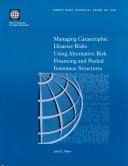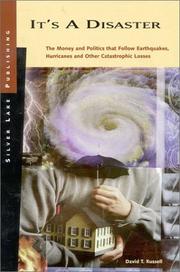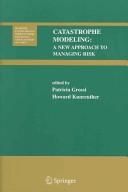| Listing 1 - 10 of 20 | << page >> |
Sort by
|

ISBN: 0821349171 Year: 2001 Volume: no. 495 Publisher: Washington, D.C. : World Bank,
Abstract | Keywords | Export | Availability | Bookmark
 Loading...
Loading...Choose an application
- Reference Manager
- EndNote
- RefWorks (Direct export to RefWorks)
Insurance --- Caribbean Area --- Disaster insurance --- Risk management --- Reinsurance --- Finance --- Business & Economics --- Catastrophe insurance --- Insurance, Disaster --- Management

ISBN: 058506010X 9780585060101 1563431726 Year: 1999 Publisher: [Place of publication not identified] Silver Lake Pub
Abstract | Keywords | Export | Availability | Bookmark
 Loading...
Loading...Choose an application
- Reference Manager
- EndNote
- RefWorks (Direct export to RefWorks)
Disaster insurance --- Natural disasters --- Insurance --- Finance --- Business & Economics --- Natural calamities --- Disasters --- Catastrophe insurance --- Insurance, Disaster --- Government policy --- Economic aspects
Book
Year: 2020 Publisher: Washington, D.C. : The World Bank,
Abstract | Keywords | Export | Availability | Bookmark
 Loading...
Loading...Choose an application
- Reference Manager
- EndNote
- RefWorks (Direct export to RefWorks)
The Philippine Parametric Catastrophe Risk Insurance Program (the 'parametric program') represents a key milestone in this partnership. In July of 2017, the Philippines placed on the international financial markets a portfolio of catastrophe risk that transferred typhoon and earthquake risk from the Philippines through the World Bank to the international reinsurance market in local currency. In 2018, the GOP purchased a second insurance policy, doubling the amount of coverage. The two-year pilot has now ended, although many of the lessons learned and technical work undertaken have proved useful in the subsequent preparation and placement of the GOP catastrophe (CAT) bond in December 2019. As part of closing this activity, the World Bank commissioned a lessons-learned evaluation to help all par ties involved better understand the successes and challenges of the program, and guide their continued efforts to improve financial preparedness to disasters in the Philippines. The evaluation is also mean t to build the evidence base on parametric insurance and allow for knowledge sharing with similar programs that are being explored or implemented in other countries. This report discusses the findings from the evaluation.
Book
Year: 2020 Publisher: Washington, D.C. : The World Bank,
Abstract | Keywords | Export | Availability | Bookmark
 Loading...
Loading...Choose an application
- Reference Manager
- EndNote
- RefWorks (Direct export to RefWorks)
This report was prepared at the request of the ministry of finance (MoF) and ministry of emergency situations of Uzbekistan as of February 2019. It aims to provide a detailed overview of the current status of disaster insurance for residential property in the country, identify gaps, and provide recommendations for a way forward. Uzbekistan is prone to many natural disasters that have a devastating potential for the economy and the population. It is widely recognized that disaster insurance can reduce the fiscal impact of natural disasters as well as their adverse economic impact on the population; and lead to a faster post-disaster recovery. Disaster insurance in Uzbekistan is offered by the private insurers. The Government of Uzbekistan (GoU) can consider the following actions to further strengthen disaster insurance: (i) establish a centralized disaster insurance national pool in the form of a public-private partnership; (ii) improve regulatory framework for disaster insurance; (iii) strengthen the insurance supervision of the disaster insurance market and introduce adequate reporting of catastrophe risk accumulations retained by insurance companies; and (iv) invest in better risk information systems. The report is structured in three main parts. The first part provides an overview of Uzbekistan disaster profile and buildings' seismic vulnerability based on a risk assessment performed for the Kyrgyz Republic. The second part provides an overview of the local insurance market, disaster insurance line of business, and analyzes the current gaps in coverage and regulation. The third part reviews four examples of disaster insurance programs from the Kyrgyz Republic, Romania, Turkey, and New Zealand.
Catastrophe Insurance --- Environment --- Finance and Financial Sector Development --- Hazard Risk Management --- Insurance --- Insurance and Risk Mitigation --- Natural Disasters --- Urban Development
Book
Year: 2020 Publisher: Washington, D.C. : The World Bank,
Abstract | Keywords | Export | Availability | Bookmark
 Loading...
Loading...Choose an application
- Reference Manager
- EndNote
- RefWorks (Direct export to RefWorks)
Natural disasters in APEC (Asia-Pacific Economic Cooperation) economies have significant impacts on the economy and daily lives of the population. To minimize those impacts, a comprehensive policy package is required, which covers the key strands of prevention, preparedness and response. The establishment of an insurance scheme to support the financial protection of public assets against disasters can form an important part of this package, alongside the use of complementary financial instruments within a broader disaster risk financing strategy, and investments in quality, resilient infrastructure and buildings to prevent losses. This report aims to synthesize peer-to-peer learning among APEC economies into a document that provides useful, practical guidance to finance officials about the design and implementation of catastrophe risk insurance programs for public assets based on case studies of APEC economies and beyond.

ISBN: 1280147717 9786610147717 0387231293 0387230823 0387241051 Year: 2005 Publisher: New York, NY : Springer Science+Business Media,
Abstract | Keywords | Export | Availability | Bookmark
 Loading...
Loading...Choose an application
- Reference Manager
- EndNote
- RefWorks (Direct export to RefWorks)
Catastrophe Modeling: A New Approach to Managing Risk is the first book that systematically analyzes how catastrophe models can be used for assessing and managing risks of extreme events. It focuses on natural disaster risk, but also discusses the management of terrorism risk. A unique feature of this book is the involvement of three leading catastrophe modeling firms, AIR Worldwide, EQECAT, and Risk Management Solutions, who examine the role of catastrophe modeling in rate setting, portfolio management and risk financing. Using data from three model cities (Oakland, CA, Long Beach, CA and Miami/Dade County, FLA), experts from the Wharton School of the University of Pennsylvania examine the role of catastrophe modeling to develop risk management strategies for reducing and spreading the losses from future disasters. Given the uncertainties associated with terrorism the book points out the opportunities for utilizing catastrophe models to set insurance rates and to examine public-private partnerships for providing financial assistance in the event of a terrorist attack. "This book fills a critical need in setting forth the role of modern risk analysis in managing catastrophe risk. There is no comparable reference work for this important subject area. The book is well written and well organized. It contains contributions from many of the most distinguished experts in the fields of risk analysis and risk management. It strikes a good balance between the technical aspects of the subject and the practical aspects of decision making." "This book is strongly recommended for individuals who must make decisions regarding the management of impacts of catastrophe risks including those in both the public and private sector." Wilfred D. Iwan Professor of Applied Mechanics, Emeritus Director, Earthquake Engineering Research Laboratory California Institute of Technology "The authors have captured the essence of catastrophe modeling: its value, its utility and its limitations. Every practitioner in the catastrophe risk field should read this book." Franklin W. Nutter, President Reinsurance Association of America.
Risk management. --- Risk (Insurance) --- Natural disasters. --- Disaster insurance. --- Catastrophe insurance --- Insurance, Disaster --- Insurance --- Natural calamities --- Disasters --- Management --- Risk --- Finance. --- Microeconomics. --- Finance, general. --- Price theory --- Economics --- Funding --- Funds --- Currency question
Book
ISBN: 0821395793 9786613802194 0821395807 1282108840 Year: 2012 Publisher: Washington D.C. : World Bank,
Abstract | Keywords | Export | Availability | Bookmark
 Loading...
Loading...Choose an application
- Reference Manager
- EndNote
- RefWorks (Direct export to RefWorks)
This applied study addresses the large flood exposures of Central Europe and proposes efficient financial and risk transfer mechanisms to mitigate fiscal losses from such natural catastrophes. In 2010 the V-4 Visegrad countries (i.e., Poland, Czech Republic, Hungary and Slovakia) demonstrated their historical vulnerability to floods - Poland suffered 3.2 billion in flood related losses, comparable to it 3.5 billion of losses in 1997. Flood modeling analysis of the V-4 shows that a disaster event with a 5 percent probability in any given year can lead to economic losses in these countries of
Disaster insurance -- Europe, Central. --- Financial risk management -- Europe, Central. --- Floods -- Europe, Central. --- Financial risk management --- Disaster insurance --- Floods --- Management --- Business & Economics --- Management Styles & Communication --- Flooding --- Inundations --- Catastrophe insurance --- Insurance, Disaster --- Natural disasters --- Water --- Insurance --- Risk management
Book
ISBN: 9264234241 9264234233 Year: 2015 Publisher: Paris, France : Organisation for Economic Co-operation and Development,
Abstract | Keywords | Export | Availability | Bookmark
 Loading...
Loading...Choose an application
- Reference Manager
- EndNote
- RefWorks (Direct export to RefWorks)
The publication provides an overview of the disaster risk assessment and financing practices of a broad range of economies relative to guidance elaborated in G20/OECD Framework for Disaster Risk Assessment and Risk Financing. The publications is based on survey responses provided by 29 economies, as well as research undertaken by the OECD and other international organisations, and provides a global overview of the approaches that economies facing various levels of disaster risk and economic development have taken to managing the financial impacts of natural and man-made catastrophes.
Disasters --- Risk management --- Disaster relief --- Disaster insurance --- Economic History --- Business & Economics --- Economic aspects --- Risk assessment --- Finance --- Calamities --- Catastrophes --- Catastrophe insurance --- Insurance, Disaster --- Curiosities and wonders --- Accidents --- Hazardous geographic environments --- Insurance --- Management --- Disaster insurance. --- Economic aspects. --- Risk assessment. --- Finance.
Book
ISBN: 0821365835 0821365843 9780821365830 9786610765768 1280765763 1429458356 Year: 2006 Publisher: Washington, DC : World Bank,
Abstract | Keywords | Export | Availability | Bookmark
 Loading...
Loading...Choose an application
- Reference Manager
- EndNote
- RefWorks (Direct export to RefWorks)
The persistent potential for large scale natural disasters has become a real concern for the Turkish government since the late 1990's, which ultimately led to the establishment of the Turkish Catastrophe Insurance Pool (TCIP). Among the main rationale of the creation of the TCIP were a grave government fiscal exposure to natural disasters and a disproportionately low level of catastrophe insurance penetration for such a disaster-prone country. Since the commencement of this program in 2000, the TCIP has provided coverage to more than 2 million households, being by far the largest insurance program
Social policy --- Insurance --- Geophysics --- Turkey --- Earthquake insurance --- Insurance pools --- Turkish Catastrophe Insurance Pool. --- Insurance purchasing alliances --- Insurance purchasing cooperatives --- Insurance purchasing pools --- Insurance syndicates --- Pools, Insurance --- Syndicates (Finance) --- Insurance, Earthquake --- TCIP
Book
Year: 2020 Publisher: Washington, D.C. : The World Bank,
Abstract | Keywords | Export | Availability | Bookmark
 Loading...
Loading...Choose an application
- Reference Manager
- EndNote
- RefWorks (Direct export to RefWorks)
China has long known more than its fair share of disasters, including earthquakes, typhoons, floods, and droughts. The good news is that in recent decades, the country has made tremendous headway in building its resilience to disasters. Learning from these efforts will be critical to strengthening resilience building efforts in China and beyond. In that spirit, this Knowledge Note distills some lessons from China's progress in many areas of disaster risk management. The note does not comprehensively cover the country's achievements but focuses instead on topics that might be of interest to DRM practitioners globally. Drawing on expert insights from China's disaster risk management community, key themes highlighted by this note include: the evolution of national disaster risk reduction (DRR) planning; the rise of demonstration communities; standardization of the disaster loss statistical system; development of an agricultural insurance system; establishment of a catastrophe risk insurance system. China has also made significant progress in establishing a catastrophe risk insurance system that allows for local innovations and pilots based on local characteristics; Development of a comprehensive space-based system of disaster and emergency monitoring. Amid a changing climate, China is facing the specter of even more significant disaster risks in the future, which may also bring global cascading impacts. Taking stock of the progress that has been achieved so far, there is good reason to believe that the country will continue to learn and innovate toward a resilient future.
Agriculture --- Catastrophe Insurance --- Earth Sciences and GIS --- Environment --- Environmental Disasters and Degradation --- Finance and Financial Sector Development --- Hazard Risk Management --- Insurance --- Insurance and Risk Mitigation --- Natural Disasters --- Prevention --- Risk Management --- Science and Technology Development --- Urban Development
| Listing 1 - 10 of 20 | << page >> |
Sort by
|

 Search
Search Feedback
Feedback About UniCat
About UniCat  Help
Help News
News